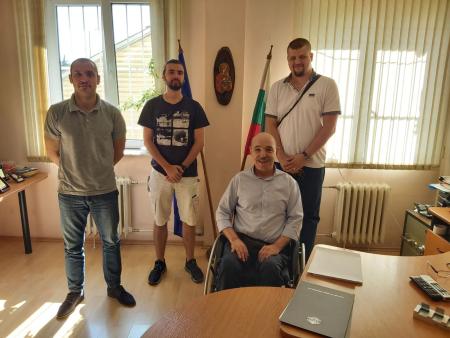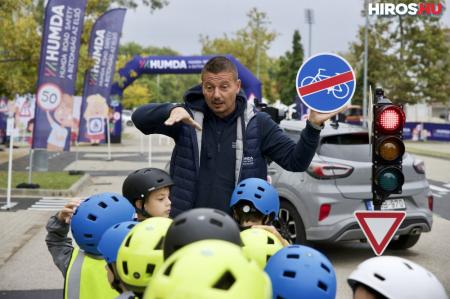Our members are dedicated to improving road safety and sharing their knowledge with the wider community. Here, you can explore our members' good practices – initiatives that have been assessed for their effectiveness in addressing a road safety problem and have proven results.
Get inspired – and sign up to share your good practices too!

to
Нашите цели бяха:
1. Да реализираме успех, от който други млади хора да се учат и да следват, целящ да популяризира
доброволното и солидарно начало в обществото.
2. Да превърнем градската среда в една по-уютно и приемащо място за хората, които се чувстват изолирани
3.Да създадем условия за равен достъп на хората с увреждания до услуги - Вярваме, че чрез този проект
можем да дадем добър пример на младежите в града да бъдат социално ангажирани и инициативни към
проблемите на заобикалящата ги среда. Хората с увреждания в България са сериозно изолирани от социалния
живот в един град и това ги кара да се чувстват нежелани от обществото. Смятаме, че с малки, но правилни
стъпки можем да бъдем инициаторите на ценностна промяна не само в нашия град, но и в цялата страна.
Искаме тези хора да имат равен достъп до всяка една услуга, било то публична или частна. Да се чувстват
равноправни граждани на нашия град.
3. Да възпитаме ценности като солидарност и приемственост у младите хора чрез повишаване на социалната
им ангажираност в града - искаме чрез този проект да покажем, че всеки млад човек може да промени средата,
в която живее, ако бъде инициативен и социално ангажиран.
4. Да ангажираме максимален брой местни жители на района с проблемите на хората с увреждания
1. Да реализираме успех, от който други млади хора да се учат и да следват, целящ да популяризира
доброволното и солидарно начало в обществото.
2. Да превърнем градската среда в една по-уютно и приемащо място за хората, които се чувстват изолирани
3.Да създадем условия за равен достъп на хората с увреждания до услуги - Вярваме, че чрез този проект
можем да дадем добър пример на младежите в града да бъдат социално ангажирани и инициативни към
проблемите на заобикалящата ги среда. Хората с увреждания в България са сериозно изолирани от социалния
живот в един град и това ги кара да се чувстват нежелани от обществото. Смятаме, че с малки, но правилни
стъпки можем да бъдем инициаторите на ценностна промяна не само в нашия град, но и в цялата страна.
Искаме тези хора да имат равен достъп до всяка една услуга, било то публична или частна. Да се чувстват
равноправни граждани на нашия град.
3. Да възпитаме ценности като солидарност и приемственост у младите хора чрез повишаване на социалната
им ангажираност в града - искаме чрез този проект да покажем, че всеки млад човек може да промени средата,
в която живее, ако бъде инициативен и социално ангажиран.
4. Да ангажираме максимален брой местни жители на района с проблемите на хората с увреждания

to
We are providing an easy and fun learning experience for children, so they will develop the habit of safe travelling. With this habit, they will be more inclined to learn about road safety in the future and in return this will result in more responsible people on the roads, less accidents and an all-around safer environment.

to
Urban mobility is not gender-neutral. Public and shared transport often fails to accommodate the diverse and complex mobility needs of women. Men in the UK continue to make twice as many cycle trips compared to women . We see this pattern emerging in new forms of micromobility too, like escooters, but not everywhere and we need to identify what broader factors are negatively affecting uptake. Our ridership profile in the Nordics is close to even between women and men, all countries with longer histories of gender inclusion, suggesting micromobility may not be the challenge to increased adoption. TIER is committed to understanding how micromobility innovation can respond to barriers that prevent women from moving freely in cities, and to develop and share best practices across the 500+ cities we operate in. To change mobility for good, and understand the mobility needs of women, TIER partnered with Safe & the City to conduct a multi-regional study of 403 women in the UK and 411 women in Berlin. Note that this study is part of a broader shift within TIER, including Women of TIER, which strives for a diverse and inclusive workplace and industry by showcasing female role models and a DEI strategy to improve representation at all levels of our business so it too reflects a more inclusive rider base.

to
La alta siniestralidad vial sufrida por los trabajadores que emplean motocicletas durante su trabajo. Reducir la siniestralidad vial con motocicletas, mejorar la formación en seguridad vial y transmitir buenas prácticas a todos las personas trabajadoras que empleen motocicletas en su dÃa a dÃa. Todas las empresas que están asociadas a umivale y sus trabajadores. Nuestro público objetivo son más de 46.300 empresas y 848.300 personas trabajadoras en las mismas.

to
66% of road accidents in Slovenia happen in built-up areas (data for 2020). This means that two out of every three traffic accidents take place on roads where the most vulnerable users are present – pedestrians, children, old people, cyclists. This also means that accidents happen within local communities – both the person causing the accident and the victim are often from the same community. Slovenia is a very dispersed country, with 2 million inhabitants living spread out in 212 municipalities, which are in charge of local roads in their specific areas. According to research data, localised, locally adapted campaigns addressing road safety are 150% more successful than general, national ones. This means that all of us participants in traffic are more motivated to be part of traffic solutions in our community – where our children are on the street. Can all this be used in planning and implementing sustainable solutions in local communities? Is it possible to implement a programme that is custom-made for specific problems of each local community, which at the same time is applicable to all local communities in Slovenia and beyond? Can we do anything to equip, empower and motivate local communities to create their own safer future? Zavarovalnica Triglav, the oldest and biggest insurance company in Slovenia, approached this well-known problem in a different way. Our line of business – through car insurance – is indeed so closely tied in to road safety that we see preventive safety activity as part of our core business. We brought together the best technological partners in the field of road innovation, our own knowledge from years of observing damage events, and leading experts in the field of road safety. With this reinforcement we linked up with decision-makers and other key groups in each of the local communities, invited the local media to participate and set ourselves an ambitious goal: to achieve long-term, sustainable and measurable improvements in road safety in local communities. We realised that in traffic safety we were in for the long haul, so we set out a multi-year, long-term programme that we are building on. "A core goal of the ""Together for road safety – empowering communities 360°"" is to combine the best partners that Slovenia has to offer in the field of road safety and implementation of a modular programme, which in the 360° model addresses all target groups in the local community for sustainable, measurable and long-term progress in the area of traffic safety. The aim is to secure a measurable long-term change in road users and a measurable change/improvement in traffic statistics in the individual local community. Objectives 2016 – 2021 Local community: Enter into sustainable, long-term cooperation with at least 44 Slovenian municipalities (20% of all municipalities) to achieve lasting change at critical black spots in the individual community: 1) First stage: objectives associated with negative statistics and critical infrastructure points in the individual local community: o Reduce the number of speeding drivers in the vicinity of schools, nursery schools and on the way to school – by 5% o Reduce the number of accidents at accident black spots, since most accidents happen because of poor visibility – by 50% o Eliminate fatalities at railway level crossings that are marked only by a St Andrew's cross – 0 fatalities one year after installation o Improve the safety of pedestrian crossings near schools and nursery schools – increase the attention of pedestrians by 10% 2) Second stage: objectives associated with changing the behaviour of drivers in the local community. a. Gather, research and analyse various driving habits of long-term drivers in Slovenia – conduct research in 10/12 regions b. Enable long-term drivers, who are the most frequent cause of traffic accidents, to renew their practical traffic knowledge within their environment, on roads where they drive every day – in 12/12 regions c. Ensure that drivers who already have a driving licence can renew forgotten or acquire new knowledge about road and traffic regulations – achieve at least 10%, i.e. 130,000 Slovenian drivers d. Offer drivers in local communities who are safer a reward in the form of a discount on their insurance premium. Primary: Entities responsible for road safety in municipalities: Roads in villages and small towns (equipment, maintenance) are generally operated by municipalities, which are faced with a shortfall in funding for even the most urgent maintenance. Additional traffic signalling and the elimination of blind spots and areas where visibility is poor are therefore often deficient. Drivers in local communities: Slovenian drivers do not adjust their driving sufficiently to take account of driving conditions in built-up areas. In 2020, 66% of all road accidents occurred in such areas. Two of the most common causes of accidents were a failure to give way and excessive speed (Source: Slovenian Traffic Safety Agency). Those who most frequently cause fatal traffic accidents are aged 45 to 64 years – in other words middle-aged people who have been driving for many years. These drivers passed their test 25 to 40 years ago. In that time the transport infrastructure, cars and road traffic regulations have all changed. These drivers are not required to refresh their driving knowledge and skills. Primary schools in the communities: Primary schools are generally located in the centre of built-up areas, although pressures of space mean that they can be found outside those areas as well. Road safety issues are addressed through various primary school programmes organised by the police and the Traffic Safety Agency. Because of the relatively small size of local environments (primary schools have an average of 200 pupils according to the Statistical Office of the Republic of Slovenia), pupils most commonly walk to school unaccompanied. They are therefore active road users from an early age (the law permits children to walk to school on their own from the age of seven). Secondary: Traffic police in local communities: In smaller Slovenian towns or villages, station-based police officers are responsible for road safety. This is usually a very small team who work with the municipality and their parent police station to ensure road safety and carry out traffic controls. The problem faced by local police officers is mainly one of staff shortages, a lack of time to spend in the field or a lack of tools to help them take action at a critical section at the right time. Local media: Local media, especially radio stations, are still the most influential media when it comes to local issues in Slovenia. We picked the most popular radio stations and other local media for each region or community and invited them to address their listeners to help improve very specific accident black spots in the local environment.